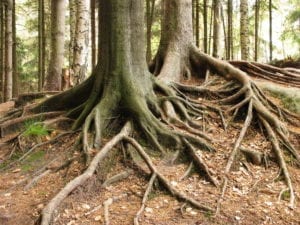I was hiking on the North Shore of Lake Superior in May and noticed a young tree holding tightly onto its root system, eroded by the swirls of intense water from recent storms. As I looked more closely, I noticed that another larger root from a neighboring tree had expanded to create some protection for its younger neighbor, directing water to the root system of the growing tree.
This amazing visual reminded me of an important design principle within nature – that cooperation is rewarded. Nature diversifies as its ecosystems evolve. This diversity creates opportunities for different species to create reciprocal relationships that exchange nutrients and create even more mutually beneficial relationships within living things.
The picture of a neighboring tree root expanding into the roots of a young tree is one example of cooperation that can be found in nature. We just have to look deeper to see how this cooperation is actually structured. Tree roots can share nutrients directly into the root structure of younger trees. The younger tree feeds off the nutrients of surrounding trees as it slowly grows to maturity. It is one way that trees cooperate with each other.
The relationship between cooperation and resilience in nature
Nature is also designed to become more resilient as an ecosystem becomes more diverse. As this diversity increases more cooperative relationships emerge. Monocultures like corn or soybean fields often lose their capacity to function when disrupted. But diverse ecosystems have a high degree of resilience. When a corn crop experiences a hailstorm much of the crop can be ruined for the season. When the same hailstorm hits a prairie the diversity of that natural ecosystem allows disruption and recovers from the damage because there are multiple plant species that bloom at different times over the summer. In other words, when one set of plants becomes hurt, another is ready to grow and bloom in its stead.
In nature cooperation increases resilience because everything is interdependent and connected, and support is natural. This is a different way of looking at how an ecosystem or an organization can behave. What if our workspaces worked on the principle that by rewarding cooperation and embracing diversity our organizations would become more resilient? That cooperation and diversity, when designed into our organizations, help them thrive.
What is it that makes organizations resist nature’s design principle and instead reward separation, self-interest and homogeneity? Why do we see the lack of diversity as something that helps our organizations thrive when nature – a system with 3.8 billion years of research and development into regenerative systems, would say the complete opposite?
Perhaps it is time to experiment with nature’s design for resilient systems and see where it would take our organizations and our society.
Did you enjoy reading this blog post? Sign up here to receive Dr. Kathleen Allen’s posts weekly.






